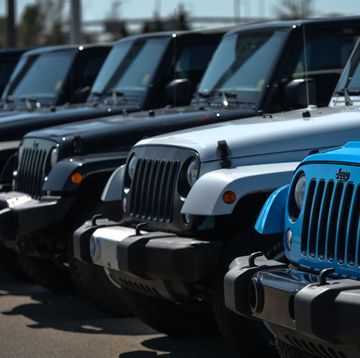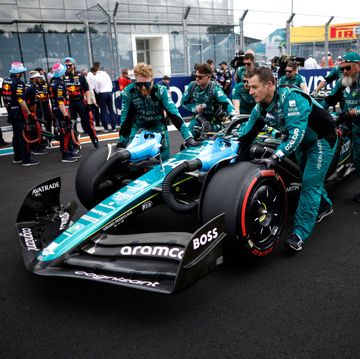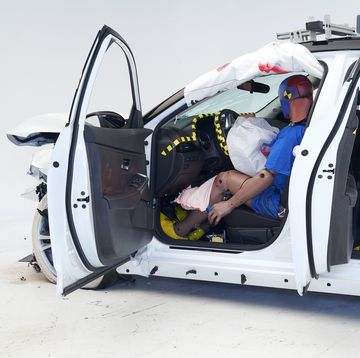- Advanced Driver Assistance Systems are helping to revolutionize road safety in the 21st century, but not all of these systems are working as intended.
- Analysis by the Insurance Institute for Highway Safety shows that some owners with ADAS-equipped vehicles experience recurring issues with repairing and re-calibrating these safety systems.
- Technicians, both at dealerships and independent shops, claim better education programs and proper tools are necessary to ensure full functionality following maintenance or crash-related repairs.
Advanced driver-assistance systems (ADAS) have been proven to reduce crashes, period. Whether it's automatic braking through the frontal collision warning system or blind-spot detection stepping in to avoid being sideswiped, these now ubiquitous systems are a significant piece of the road safety puzzle, with police-reported rear-end crashes reduced by 50%. But ADAS technology is still in its infancy and the Insurance Institute for Highway Safety says these systems are creating complexity and expense for the maintenance and repair side of the automotive industry.
Specifically, the IIHS surveyed nearly 3000 drivers about their repair experiences on cars with ADAS and found that while most consumers never had their assistance systems repaired, nearly 500 consumers who did typically had to have these systems repaired more than once.
The worst offenders were front crash prevention and blind-spot monitoring systems, with a respective 59% and 62% of owners who had their systems repaired making multiple trips to the repair shop specifically for recalibration. Naturally, these multi-visit percentages grew when factoring in repairs that involved crash damage and windshield replacement, indicating that it can be difficult to properly recalibrate these advanced systems following a crash.
Those with crash-induced repairs were most likely to have persistent problems, while those who never had the systems recalibrated typically reported no problems. Notably, those who had repairs but never had the systems re-calibrated were significantly less likely to encounter recurring problems as compared to those who repaired and re-calibrated, signaling that some repaired but un-calibrated vehicles could falsely appear as functional.
Additionally, the study found that routine, unrelated mechanical repairs sometimes led to problems with the ADAS systems, in turn requiring additional trips to the shop.
But how can we trust these systems really work if they're so difficult to calibrate and repair? Does the complexity and cost of calibration nullify the benefits of these supposed safety systems? And is it the mechanics or the manufacturers who should face the blame in this case?
The answer isn't that simple, but there's no need for panic, at least according to the IIHS. An analysis of early ADAS technology from Honda and Subaru shows these systems continue to work well, years after being introduced. Also, driver-assistance systems are relatively new, often run by fledging cameras, lidar, or radar systems that manufacturers are eager to implement. This sense of urgency from the manufacturer's side is in part an effort to keep consumers safe, but also a product advertising push to display the next big thing.
Though consumers initially benefit from these added protections, the web of dealerships and independent service providers is required to adapt quickly, and sometimes without adequate guidance. The IIHS says there is growing evidence that following specified repair procedures does not guarantee full functional restoration, and onboard vehicle diagnostics are sometimes unable to detect and/or report malfunctions.
Additionally, independent repair shops claim that manufacturers don't provide adequate information about the re-calibrating to non-dealership technicians, making independent garage fixes statistically more prone to issues down the road, according to a report from the IIHS and Crash Network.
"With the widespread confusion around the repair processes and related information and equipment access challenges, repairers sometimes have difficulty justifying the cost of the work required to follow the repair specifications provided by the manufacturers," the report reads.
"Insurers may also be reluctant to pay for labor or parts that do not make a practical difference to functional performance, even if they are prescribed by the manufacturer. What's more, if the functionality of a crash avoidance feature is not fully restored, the safety benefits that have been ascribed to it will not be realized over the life of the equipped vehicle."
Before you start worrying about your ADAS functionality, it's important to remember that of the 3000 owners surveyed, only about 16% of them had to have their systems repaired or re-calibrated. In most cases, these systems are hearty and trustworthy. Additionally, the vast majority of fixes required in this study were the result of voluntary manufacturer service bulletins or unrelated crash damage repairs. However, for those who do experience stand-alone or recurring issues, what's the right remedy?
The IIHS says the wide variability of ADAS technology makes repairs complex from manufacturer to manufacturer, meaning an industry-wide move toward standardization could streamline education and repair processes. The Institute acknowledges this is unlikely to happen anytime soon.
Manufacturers should also consider simplifying scanning and calibration procedures, as well as establishing a centralized database with repair and calibration specifications and instructions from the manufacturers for individual crash avoidance features by vehicle model and model year, the IIHS says. Finally, establishing comprehensive self-diagnostic strategies for these technologies will be essential. Using tire-pressure monitoring systems as an example, the IIHS says that actively notifying consumers and technicians whether the system is working or not will instill further confidence in the technologies.
Have advanced driver-assistance systems ever saved you from a crash? Please share your experiences below.
A New York transplant hailing from the Pacific Northwest, Emmet White has a passion for anything that goes: cars, bicycles, planes, and motorcycles. After learning to ride at 17, Emmet worked in the motorcycle industry before joining Autoweek in 2022. The woes of alternate side parking have kept his fleet moderate, with a 2014 Volkswagen Jetta GLI and a 2003 Honda Nighthawk 750 street parked in his South Brooklyn community.
















